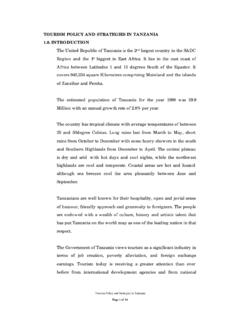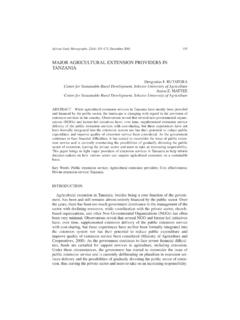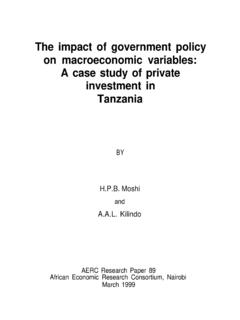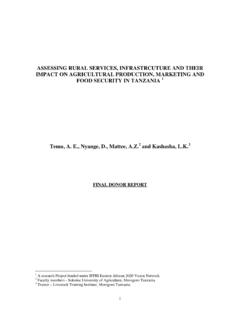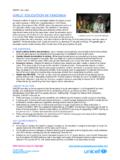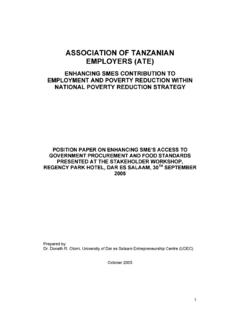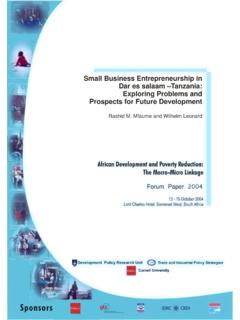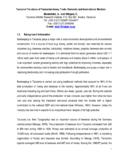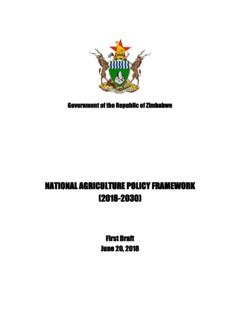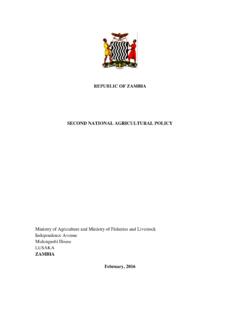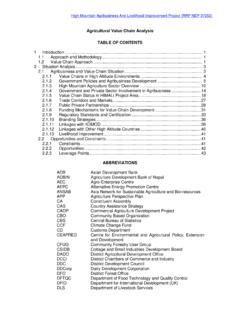Transcription of Agricultural Marketing and Supply Chain Management in ...
1 Working Paper Series No. 16 Agricultural Marketing and Supply Chain Management in Tanzania: A Case Study Elina Eskola _____ Success under Duress: a Comparison of the Indigenous African and East African Asian Entrepreneurs 2 2005_____ Agricultural Marketing and Supply Chain Management in Tanzania: A Case Study i ESRF Study on Globalisation and East Africa Economies ARGICULTURAL Marketing AND Supply Chain Management IN TANZANIA: A CASE STUDY Elina Eskola12 ABSTRACT This study describes the prevailing Marketing arrangements in Tanzania at local, regional, national and export markets using Dar es Salaam, Ifakara, and Mtwara as case study examples. The major impediments for trade in Tanzania has been categorised into three groups: 1) Physical infrastructure, 2) know-how and capital, and 3) institutional framework.
2 Insufficient physical infrastructure in terms of roads increases the cost of transportation, works as an informal market barrier, forms a wedge between the supplier price and consumer price, and increases the loss of perishable products. Lack of know-how shows in poor market orientation and business skills, and leads to difficulties in managing and obtaining loans. Furthermore, the current institutional framework is unable to support the formation of strong traders and producers associations and other representative bodies to enhance capacity building and to bargain for fairer terms of trade. In addition, the lack of market information and the weak legal framework lead to difficulties in negotiating trade agreements and enforcing the existing contracts.
3 Currently the necessary institutional framework has been substituted for by long Supply chains of middlemen, and relying on personal relationships between producers, traders and brokers. In order to realise the full potential of Agricultural trade as a tool in the fight against poverty, the suggested policy interventions are to prioritise and increase funding for physical infrastructure both from national and international sources; place emphasis on rural non-farm employment and intra-regional trade development (horizontal integration); promote large-scale capacity building in business skills and market orientation; improve equitable access to credit and improve the Management of the current schemes; enforce the existing laws and support formalisation of contracts to diminish risks of trading; and finally improve dissemination of market information to allow markets to work efficiently.
4 1 Address for correspondence: University of Sussex, Department of Economics, Arts Building E, Brighton, Falmer, BN1 9SN, United Kingdom 2 I gratefully acknowledge the helpful guidance of Dr. Josaphat Kweka and Dr. Oswald Mashindano from ESRF under whose supervision this study was carried out. I am also grateful for Frederick Rutta (Dar es Salaam), Luitfrid Singumlariji (Ifakara) and Allan Mkopoka and Anold Chiamba (Mtwara) for invaluable research assistance. Also insightful comments from Dr. Julie Litchfield (University of Sussex) helped to improve the paper. Furthermore, I am greatly indebted to all those who assisted in the implementation of the research by providing information, advice and facilities.
5 My outmost gratitude goes to the traders, buyers and other stakeholders interviewed for this study who unselfishly donated their time for this research without direct benefit. I am hoping that this report can raise topics for policy debate with aim of improving their standard of living. The research was financed with a grant from the Helsingin Sanomat Centennial Foundation. _____ Agricultural Marketing and Supply Chain Management in Tanzania: A Case Study iiTable of Contents INTRODUCTION .. 1 Agricultural MARKET 2 THE SCOPE OF THE 3 INFORMAL BARRIERS FOR 5 5 INDIVIDUAL 6 INSTITUTIONAL 7 METHODOLOGY .. 8 RESEARCH METHODS 8 GEOGRAPHICAL SCOPE OF THE 9 MARKET STRUCTURE FOR Agricultural 12 LOCAL VILLAGE 12 REGIONAL 13 NATIONAL 15 EXPORT 15 Supply Chain OF Agricultural PRODUCTS IN TANZANIA.
6 17 NATIONAL 17 EXPORT MARKET: THE CASE OF CASHEW 20 MAIN CONSTRAINTS FOR TRADE IN TANZANIA TODAY .. 24 INADEQUATE PHYSICAL 25 Road 25 Storage and market infrastructure .. 27 LACK OF KNOW-HOW AND 28 Market orientation and Business skills .. 28 Capital Risk 30 WEAK INSTITUTIONAL 31 Farmers and Traders Associations .. 31 Enforcing Contracts in Impersonal Trade The Institution of Middlemen .. 32 Corruption .. 35 policy RECOMMENDATIONS THE WAY FORWARD .. 37 REFERENCES .. 41 _____ Agricultural Marketing and Supply Chain Management in Tanzania: A Case Study 47 APPENDIX 1: PEOPLE AND ORGANISATIONS INTERVIEWED FOR THE 47 APPENDIX 2: TRANSPORTATION COSTS FROM DAR ES SALAAM TO NEIGHBOURING COUNTRIES (PER 10 TONS IN US DOLLARS).
7 51 APPENDIX 3: SUMMARY OF THE SURVEY RESULTS MEAN CHARACTERISTICS OF THE 52 APPENDIX 4: SELECTED STATISTICS OF THE DISTRICTS OF KILOMBERO (IFAKARA) AND 54 APPENDIX 5: SURVEY 55 APPENDIX 6A: MARKET ACTORS IN THE NATIONAL Supply 63 APPENDIX 6B: .. MARKET ACTORS IN THE EXPORT Supply Chain FOR CASHEW 66 _____ Agricultural Marketing and Supply Chain Management in Tanzania: A Case Study INTRODUCTION Tanzania s economy is heavily dependent on Agricultural production. In 2003 agriculture accounted for half of the country s GDP, provided 51 percent of foreign exchange and employed 80 percent of the labour force ( Agricultural Marketing policy 2005). Selling Agricultural products is the main source of cash income for most rural households. Even though the heavy dependence on agriculture is seen as a hindrance for rapid growth, and structural change is needed in the long run, the dominant role of agriculture is not likely to change in the near future.
8 Thus the government has recently started targeting Agricultural reforms as the quickest way to reduce poverty. In late 2001 the government produced the Agricultural Sector Development Strategy (ASDS) that aims to provide the basis for the rural sector of the economy to become an engine of growth, leading to a substantial reduction of poverty. This goal is also discussed in the Poverty Reduction Strategy Paper (PRSP) of 2000, where growth in agriculture was set as one of the pillars for achieving medium term targets for poverty reduction. The focus of the discussion on the Agricultural sector as a source of wealth and livelihood has traditionally been on production. However, in recent years looking at Agricultural Marketing has gained more ground in the debate as farmers have failed to sell their crops or the prices paid have been lower than expected.
9 In order to address the problems with Agricultural Marketing , the government of Tanzania is currently formulating a new Agricultural Marketing policy (AMP), which is aimed at addressing problems in Agricultural trade and facilitating the use of Agricultural Marketing as a means to enhance economic growth. In order to promote Agricultural trade and poverty alleviation, it is crucial to understand the hindrances and limitations that stakeholders face today. The government of Tanzania has carried out a substantial programme of trade liberalisation that started in the 1980 s and by 1990 virtually all restrictions on the private trade in grains had been removed. During this time, Tanzania has undergone a large-scale renewal of macro policies to enhance the trading environment and the government has streamlined the legal framework to encourage trade and investment.
10 Rapid removal of formal barriers to free trade has left the playing field open for new actors to enter, and old institutions that were previously dominant in the Marketing of Agricultural products have been forced to change form. However, the effect of the liberalisation at the macro level has not led to significant liberalisation taking place at the micro level. Many of the existing policies are yet to be implemented and even the ones that are in place, lack relevance in the environment in which the small-scale traders operate. The current situation presents prospects but also new difficulties for the market actors to exploit the opportunities that the liberalised markets have to offer. Even though the formal barriers at the national level have been removed, still various structural and informal barriers prevail at the regional and village level leading to ineffective Marketing of the Agricultural production.
